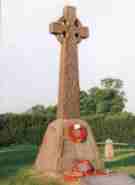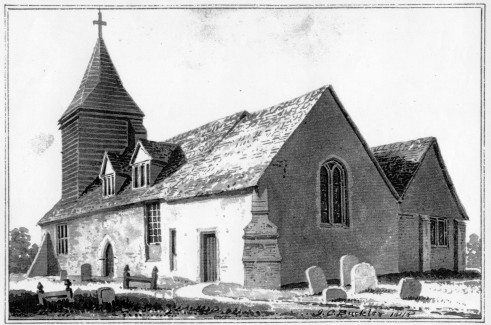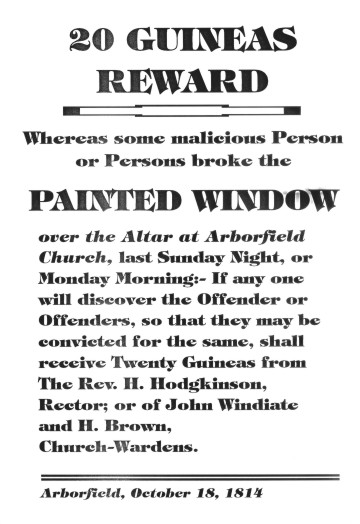
|
Arborfield
|
|
Churches
Related sites:
Arborfield Tithe Apportionment Map 1839 Photos of the old church building, just before it became disused Monuments in the old churchyard Article on old church by Ernest Dormer, 1907 Notes by Peter Ditchfield for a Berks Archaeological Society field-trip, 1922 Article in Berks Archaeological Journal, 1934 Article on the old church before removal of Conroy Chapel roof, 1939 Photos of Old Church Ruins from the late Fred Fox Articles by Leslie North in the Reading Chronicle, 1960s
|
THE WOODEN CHAPEL ( - 1256)
It was built of wood and although a good list of books and
ornaments was found there, the building is described “to be in a disgracefully
ruinous state and shamefully desecrated.” The churchyard was over-run with
cattle and uprooted by pigs. The Salisbury Diocesan Record adds that the aged
priest of Edburgefeld, who lived at the Manor House with Richard Bulloc “could
not render a single sentence of the Canon or the Gospels correctly” owing to
partial blindness. In 1224 the Chapel seems to have been in the charge of Priest John of Barkham, who was remiss in the oversight of his subordinates and the care of the Chapel. The Chapel was in the grounds of the manor and close to the
river Loddon.
1256 THE CHURCH IS REBUILT It is highly probable that the old church owes its erection to a former lord of the manor, as it was built close to the Manor House, an appended chapel to the Parish Church of Sonning. It was most likely built of chalk and flint in 1256, with a wooden tower and spire to the west-end, the church was added to in 1631. Portions of each can still be seen, though only a few walls are standing.
When the building was pulled down in 1862, the chapel to the right was rebuilt as the 'Conroy Chapel' with an arched East Window instead of the simple rectangle as shown here. The doorway on the South Wall can still be made out in the remains of the wall, now reduced to only a couple of feet above ground level.
VANDALISM'S NOTHING NEW..
ARCHDEACON RANDALL’S VISIT TO ARBORFIELD ON MONDAY, OCTOBER 8th 1855, 1.30 P.M.
Present: the Rev’d Sir John Warren Hayes, Bart., rector, Arthur Pott,
curate, 2 churchwardens. The church in a very bad condition. The roof
apparently in a state of decay. Directed it to be examined by opening it
in several places. The font, a wooden one, but lined with lead and a
pewter basin within. Directed the basin to be disused and a drain made.
Ordered table of prohibited degrees to be put in a conspicuous place.
The one nearest the window represented an “ecclesiastic”, or at least a person in ecclesiastical dress; the painting was much injured from having been exposed to the weather foe sometime, and it was almost impossible to distinguish the dress accurately, for with the exception of the mitre (which was of the low triangular shape), the outlines had been destroyed by damp; however the figures appeared to be vertical, with yellowish stripes. The next figure, for there were two under the middle canopy, were of a woman and child, the child being represented as of about 13 or 14 years old. They were both dressed in brownish drapery. The figures could represent St. Nicholas and his mother.
The third figure was again of an ecclesiastic, appearing similar in all
aspects to the figure first mentioned, with this portion of the wall
having suffered more from damp, the painting was more indistinct. Above
these figures, the wall had been painted with reddish brown paint, to
represent stones, with a little ornament in the centre of each stone. On the South and North walls, there were remains of painted drapery (also of the same reddish brown colour), the drapery being two feet wide, commencing about two feet to two and a half feet above the level of the ground, and above the drapery some kind of geometrical pattern appears to have been painted upon the wall, only slight traces were visible. This decoration appears along both the North and South walls of the church.
About the spot F, near where the pulpit had to stand, the remains of a
piscina (a stone basin near the altar in Roman Catholic and
pre-Reformation churches for draining water used in the Mass) were
visible; a plain semi-circular arch had apparently existed, but the
greater portion of this had been destroyed; and thus there only remained
a portion and the hallowed stone of the piscina, which was rather oblong
without any kind of ornament and was formed of sandstone.
I observed three encaustic tiles, the ground being of a dirty red and
the pattern formed of buff and black, each tile however containing a
portion of the pattern, it was not possible to get much idea of what
sort of a thing it had originally been, but apparently it had consisted
mainly of circles with a kind of flower shaped ornament in the middle. In 2004, a couple of tiny patches of paint were still visible on the surrounds of the East Window.
Searching Old Records Extract taken from “The Conroy Papers”: The Records in the Augmentation Office have been diligently searched but afford no material information whatever respecting this Church. The Parish of Arborfield does not occur in the Taxation of Pope Nicholas the Fourth made AD 1291. neither among the Spiritualties nor, Temporalties for which reason it may be presumed that the Parish is of more recent erection. This is somewhat unfortunate as owing to this circumstance, there will be no return of it, in a Survey made not many years afterwards entitled the Nona Roll, which Survey in many instances has been found to give not only an account of the quantity of the Glebe Land, but a description of the specific Tithes due to the Incumbent. Arborfield is an ecclesiastical Rectory and no Endowment is extant, which would most probably have been discoverable, had it been a Vicarage. The general ecclesiastical Survey taken in pursuance of an Act of Parliament edited in the twenty sixth year of Henry the Eighth, affords but little information. It appears from thence, that it was then of the yearly value of eight pounds, but whether that Amount arose from Tithes or from Glebe Land is not set forth (as it is believed) in the Records. In this Case, unless any Terriers should chance to be in existence, it does not seem that any light can be derived from ancient Records. The proper Repositories for Terriers are the Places following: Viz.
The Bishop’s Registry In addition to what has been stated as to the probability of there being Terriers of this Rectory in existence it may be mentioned that there was an ecclesiastical Survey taken of Church Benefices during the Usurpation of Oliver Cromwell, which Survey is lodged in the Library of the Archbishop of Canterbury at Lambeth, and which is sometimes found to contain an Account of the Glebe Lands, Tithes and other Dues of the Benefice so surveyed, It does not appear as far as can be judged by inspection of the Records in the Augmentation Office and various other Repositories that either the Church or any Lands within the Parish ever belonged to any Monastery so as to be entitled to any priviledges in that respect.
Arborfield seems to be a small and obscure Parish of which very
little mention is made in Records of Antiquity, Mr. Caley having
searched for it not only in many Repertoires and Calendars in his own
possession but also in the several Catalogues to the Muniments contained
in the British Museum, without meeting with any reference to it. It need
hardly be mentioned that the Incumbent of this Church being an
ecclesiastical Rector, is entitled of common Right to all Tithes as well
great and small within the Parish, upon mere proof of Institution and
Induction, not so with respect to Glebe Land, for there he must either
shew actual Usage, or Evidence of antecedent Usage from Surveys or
Terriers, it therefore would have been highly desirable to have met with
such Documents.
The Rev’d John Sale incumbent of both Parishes, died 1739 - when it
would appear that Mrs. Elizabeth Waterman - (Widow of the Mr. Waterman
mentioned) made the next two Presentations to Arborfield, which Manor
was not in the Waterman’s domain, but which after the last male Heir of
the Standens (viz. Edward Standen who died Sept. 1730) had passed to
Mr. Aldworth, a minor and subsequently father of the 1st Lord Braybrooke;
The Minor’s Guardian sold the manor of Arborfield to Mr. Pelsant Reeves,
a Master in “Chancery”, but not the Living, which Lysons in his History
of Berks says was reserved in the family of Braybrooke. So how Mrs.
Elizabeth Waterman came to present the Rev’d John Waterman in 1739 - and
the Rev Richard Hayes in 1755, who died in 1797 - (42 years Rector) and
whose table tomb is now in Good preservation in the Grave Yard of old Arborfield Church, and who the Richard Hayes Esquire is, I am at a loss
to conjecture! - on the death of Rev’d Richard Hayes in 1797, the living
was given by the then Lord Braybrooke to the Rev’d Henry Hodgkinson,
also 42 years Rector, and who dying Sept. 1839, was succeeded by the
Rev’d John Warren Hayes (2nd son of an Army Surgeon, created a Baronet
in 1787) whose friends purchased for him, many years before Mr. Hodgkinson death in 1839. The presentation to the Rectory of Arborfield,
for one life, from Lord Braybrooke, to whom it reverts on the now John
Hayes’ death. Monumental Inscriptions In 1927, a list of monumental inscriptions was made, which has preserved in writing what has since proved to be subject to decay in lapidary form. Click here for more details. In the Reading Mercury, 29th February, 1930, there was a list of inscriptions in the old Conroy Chapel. Also in the Mercury, on 15th May 1930, but not recorded in detail here, was a list of the tablets in the Old Church: Standen; Edith Hargreaves; Edward 4th Viscount Exmouth; Washington Jackson; Anna Maria, wife of Washington Jackson; Arthur Hargreaves; Pelsant Reeves; George Dawson; John Reeves. The tablets were later transferred to the walls of the new church.
Bartlemas
The Feast of Saint Bartholomew the Apostle - AUGUST 24th
Other References Leslie North published a History column in the Reading Chronicle and its predecessors over the years. Click here to see some extracts. Ernest Dormer, writing in the Reading Mercury over half a century earlier, wrote another article describing the Old Church. Click here to see it. The Berkshire Archaeological Journal published an article in 1934 on the stained glass from the old church. Click here to see it.
|
||
|
Any Feedback or comments on this website? Please e-mail the webmaster |

